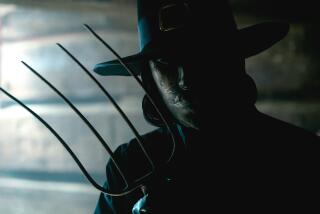Pilgrims’ Progress in Plymouth
- Share via
PLYMOUTH, Mass. — Finally, it was time to celebrate.
The first harvest was a success, Samuel Fuller told us, and after such a long, bitter winter--only half of the founding group had survived--the new community was ready for a big party. They wanted to thank God and share their good fortune with their American Indian neighbors. Without the Indians’ help and the corn an Indian had taught them to plant, the Pilgrims knew they would not have made it at all.
That famous party--the one we commemorate this month by eating too much turkey--lasted three days in the fall of 1621. Ninety Indians came, contributing five deer. They joined the 52 surviving Pilgrims--including 23 children and just four women--for wild turkey, fish, bread, fruit tarts and beer, among other things.
“Everyone had a fine time,” Samuel Fuller recalled, standing outside his tidy thatched-roof house in the middle of Plimoth Plantation. He was the community’s surgeon and he was speaking to us from the past: 1627 at Plimoth Plantation, six years after that first Thanksgiving feast.
The tiny Pilgrim settlement is prospering. Nearby, one woman is plucking a duck. Another is tending her garden behind her house.
She asks us where we’re from. “Chicago,” I say. She looks perplexed. “There are so many new settlements,” she says, shaking her head.
*
Talk about bringing history alive for children. For a few hours on a recent drizzly fall afternoon, we really are back in 1627. Here at Plimoth Plantation, members of the museum staff--this is a not-for-profit educational organization--never waver from their roles as the English colonists who arrived here on the Mayflower and the ships that followed.
My children, 9-year-old Matt and 7-year-old Reggie, are at first confused but then get into the spirit. Matt wants to know what kind of guns the men have; Reggie is amazed to learn that most people can’t read.
The Pilgrims patiently permit us to poke around their homes, fingering their pots, trying their beds, feeling the rough fabrics of their clothing. They answer all of our questions about their lives in 17th-Century dialect, as they go about their daily chores.
My kids especially liked one Pilgrim practice: If children misbehaved in church, their parents were punished--even put in the stockade outside the fort/ meeting house. But we also learned that the Pilgrim’s idea of Thanksgiving was not a food-oriented holiday but that of spending the day praying and probably fasting. (The kids couldn’t imagine anything worse.)
Today, of course, the Thanksgiving holiday is celebrated with fanfare and feasting here at Plimoth Plantation and in the nearby picturesque town of Plymouth, 40 miles south of Boston. Thousands come here every year just to be part of it. (Although this year’s Thanksgiving celebration dinners are sold out, similar 17th-Century harvest feasts have openings at varying times this fall. Call 508-746-3440 for reservations and information.) Plimoth Plantation closes for the winter right after Thanksgiving weekend, although later tours can be arranged for groups. It will reopen April 1.
During a wonderful evening Colonial Lantern Tour of historic Plymouth, fourth-grade teacher and Pilgrim historian Diane Finn explains how the surprisingly small (perhaps 10-feet-by-3-feet) Plymouth Rock we see now is just one-third its original size. Part is under the sand. The rest was chipped away by early souvenir hunters, including the Revolutionary Patriots who seized on the rock as a symbol of democracy. (For more about the lantern tours, call New World Tours 508-747-4161.)
Throughout our explorations of the area, everyone takes great pains to make sure the American Indians’ story was told. We visited Hobbamock’s Homesite and inspected a bark house just outside the plantation.
Then we headed out to visit some of the passengers aboard the reproduction of the Mayflower. But Matt and Reggie lost interest quickly once they realized they couldn’t climb the mast. It was time, I realized, to return to the 20th Century.
Taking the Kids appears the first and third week of every month.
More to Read
Sign up for The Wild
We’ll help you find the best places to hike, bike and run, as well as the perfect silent spots for meditation and yoga.
You may occasionally receive promotional content from the Los Angeles Times.






